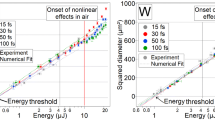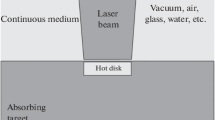Abstract
UV-laser ablation is described in terms of a two-level system in which the excitation energy is dissipated via stimulated emission, thermal relaxation, and activated desorption of excited species. For thermal relaxation times t T>10−9 s and ΔE* ≪ ΔE (activation energies for excited-state and ground-state species) the model predicts high ablation rates at moderate surface temperatures, typically below 2000° C.
Similar content being viewed by others
References
D.C. Paine, J.C. Bravman (eds.): Laser Ablation for Materials Synthesis. MRS Symp. Proc., Vol. 191 (MRS, Pittsburgh, PA 1990)
J.C. Miller, R.F. Haglund, Jr. (eds.): Laser Ablation - Mechanisms and Applications, Lect. Notes Phys., Vol. 389 (Springer, Berlin, Heidelberg 1991)
E. Fogarassy, S. Lazare (eds.): Laser Ablation of Electronic Materials - Basic Mechanisms and Applications, Proc. E-MRS, Vol. 4 (North-Holland, Amsterdam 1992)
R. Srinivasan, B. Braren: Chem. Rev. 89, 1303 (1989)
R. Srinivasan: In Interfaces under Laser Irradiation, NATO ASI Series, ed. by L.D. Laude, D. Bäuerle, M. Wautelet (Nijhoff, Dordrecht 1987) p. 359
D. Bäuerle, B. Luk'yanchuk, P. Schwab, X.Z. Wang, E. Arenholz: in Ref. [3] p. 39
S.R. Cain, F.C. Burns, C.E. Otis: J. Appl. Phys. 71, 4107 (1992)
S.R. Cain, F.C. Burns, C.E. Otis, B. Braren: J. Appl. Phys. 72, 5172 (1992)
R. Sauerbrey, G.H. Pettit: Appl. Phys. Lett. 55, 421 (1989)
S. Küper, J. Brannon, K. Brannon: Appl. Phys. A 56, 43 (1993)
G.H. Pettit, R. Sauerbrey: Appl. Phys. A 56, 51 (1993)
J. Guillet: Polymer Photophysics and Photochemistry. An introduction to the study of photoprocesses in macromolecules. (Cambridge Univ. Press, Cambridge 1985)
Y.A. Bykovskii, V.N. Lisyutenko, M.M. Potapov, A.A. Chistyakov: Sov. J. Quant. Electron. 16, 667 (1986)
G. Arjavalingam, G. Hougham, J.P. LaFemina: Polymer 31, 840 (1990)
B.J. Garrison, R. Srinivasan: J. Appl. Phys. 57, 2909 (1985)
S.I. Anisimov, M.I. Tribel'skii: Sov. Sci Rev: Sect. A; Phys. Rev. 8, 259 (1987)
T.L. Cottrell: Strength of Chemical Bonds (Butterworths, London 1958)
Author information
Authors and Affiliations
Additional information
On leave from General Physics Institute, Russian Academy of Sciences, 117942 Moscow, Russia
On leave from Institute of Applied Physics, Russian Academy of Sciences, 603600 Nizhnii Novgorod, Russia
On leave from L.D. Landau Theoretical Physics Institute, Russian Academy of Sciences, 142432 Chernogolovka, Moscow region, Russia




